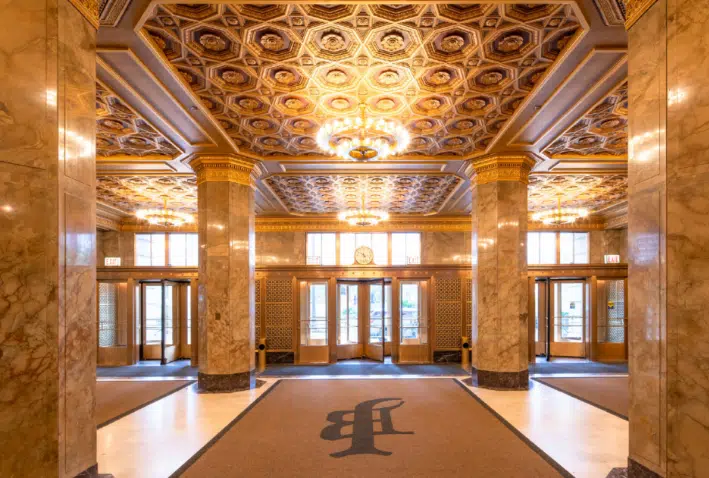The Jewelers Building Sale: What It Means for Chicago’s Office Market
The recent sale of the iconic Jewelers Building at 35 E Wacker Drive in Chicago’s Loop has captured the attention of real estate professionals, investors, and market observers. This nearly century-old Beaux-Arts skyscraper, which was once among the tallest in the world, has a storied history and a prime location along the Chicago River. Now, with its acquisition by developers Prime Group and CRG for $35.5 million, the building is poised for a new chapter that will have significant implications for various stakeholders in the Chicago office market, including investors, occupiers, buyers, and sellers.
The Jewelers Building: A Historic Overview
Before diving into the implications of the sale, it’s important to appreciate the history of the Jewelers Building. Completed in 1926, the building was designed in the Beaux-Arts style that dominated Chicago’s architectural landscape following the 1893 World’s Fair. Standing at 40 stories and 502 feet tall, the structure was a marvel of its time, featuring a distinctive terracotta façade and a unique vehicle elevator that led to a 23-story parking garage at its center—a revolutionary feature in the era before the widespread adoption of more modern automobile designs.
The Jewelers Building quickly became a central hub for the city’s jewelry trade, housing numerous businesses within its expansive 556,200-square-foot interior. Over the years, it has been home to various tenants, including the Elgin National Watch Company, which contributed to the six-ton clock that still adorns the building’s corner. More recently, the building served as the headquarters for St. Louis-based Clayco and its design arm, Lamar Johnson Collaborative.
Today, as the Jewelers Building enters a new phase under Prime Group and CRG ownership, it remains nearly 80% leased, a testament to its enduring appeal in the heart of Chicago’s Loop.

Implications for Investors
For investors, the sale of the Jewelers Building underscores several key trends in the Chicago office market, particularly the growing interest in adaptive reuse and mixed-use developments. With traditional office space demand in flux due to the rise of remote work and hybrid models, investors are increasingly seeking properties that offer flexibility in terms of use and revenue generation.
The potential hotel conversion of a portion of the Jewelers Building is a prime example of how investors can adapt to these changing market dynamics. By diversifying the building’s functions, Prime Group and CRG are preserving a piece of Chicago’s architectural history and positioning the property to attract a wider range of tenants and visitors. This approach mitigates the risks associated with relying solely on office tenants and opens up new opportunities for income through hospitality and possibly retail spaces.
Additionally, the relatively low purchase price of $35.5 million compared to other landmark properties in Chicago suggests significant upside potential for investors willing to undertake the necessary renovations and repositioning. The ability to unlock additional value through strategic redevelopment is a key factor that will likely drive investor interest in similar historic properties in the city.
Implications for Occupiers
For current and potential occupiers of the Jewelers Building, the ownership change could bring challenges and opportunities. On the one hand, the involvement of experienced developers like Prime Group and CRG suggests that the building will likely receive significant investments in modernization and amenities, which could enhance the overall tenant experience. Occupiers might benefit from upgraded common areas, improved building systems, and potentially, new on-site amenities such as dining or retail options if the hotel conversion moves forward.
On the other hand, occupiers may also face disruptions during the redevelopment process, especially if major construction is required to facilitate the building’s transformation. Tenants will need to weigh the benefits of staying in a historically significant building in a prime location against the potential inconveniences of ongoing renovations. For some businesses, particularly those in the creative or tech sectors, the appeal of working in a unique, historically rich environment may outweigh any temporary disruptions.
For those considering leasing space in the building, the potential for a mixed-use environment that includes office and hospitality components could be highly attractive. Businesses that prioritize location and a distinctive work environment may find the Jewelers Building ideal, particularly if the new owners successfully blend modern amenities with the building’s historic charm.
Implications for Buyers
The sale of the Jewelers Building also has broader implications for other potential buyers in the Chicago office market. As more historic buildings come onto the market, buyers must carefully evaluate the potential for adaptive reuse and the costs associated with such projects. The Jewelers Building serves as a case study in the value derived from purchasing well-located, architecturally significant properties that may be underutilized in their current form.
Buyers interested in entering the office market will need to consider the purchase price and the long-term investment required to reposition these types of properties. This includes the costs of preserving historical elements, upgrading building systems, and potentially reconfiguring spaces to accommodate new uses, such as hospitality or residential units.
The trend toward mixed-use developments in historic buildings will likely continue, as it offers a way to balance preservation with profitability. Buyers who can successfully navigate the complexities of such projects stand to benefit from the strong demand for unique, adaptable spaces in urban environments like The Loop.

Implications for Sellers
The sale of the Jewelers Building highlights the importance of timing and market positioning for sellers. As the office market continues to evolve, sellers of historic properties must be attuned to the needs and interests of a diverse pool of buyers, including developers, investors, and those looking for unique spaces that can be adapted for multiple uses.
The Jewelers Building’s sale price of $35.5 million balances its historical significance, current lease status, and future potential under new ownership. Sellers in the market for similar properties will need to consider these factors when determining their asking prices and marketing strategies.
Moreover, sellers should be prepared to present a compelling narrative around the property’s history, location, and potential for adaptive reuse. In a competitive market, articulating a vision for how a historic building can be transformed into a vibrant, mixed-use space will be key to attracting serious buyers and achieving favorable sale terms.
Conclusion
The sale of the Jewelers Building is a significant event in the Chicago office market, with far-reaching implications for investors, occupiers, buyers, and sellers alike. As the market continues to adapt to changing work patterns and evolving demands for urban spaces, the future of historic properties like the Jewelers Building will depend on stakeholders’ ability to creatively reimagine their use while preserving their architectural heritage.
Understanding these dynamics is crucial for those involved in the Chicago real estate market, whether as investors, occupiers, buyers, or sellers. As always, navigating such complexities is where the expertise of a knowledgeable Commercial Real Estate Agent in Chicago becomes indispensable.


